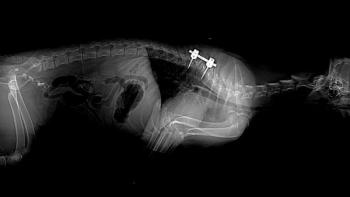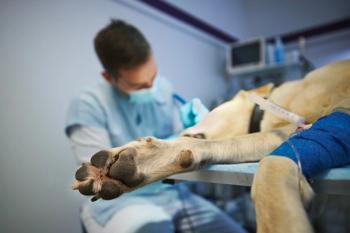
A logical approach to changed mental status (Proceedings)
Evaluation of mental status is a subtle and extremely important skill that requires input from the owner in addition to professional evaluation. Changes in mental status can indicate simply a minor systemic illness, or could indicate dangerously high intracranial pressure.
Evaluation of mental status is a subtle and extremely important skill that requires input from the owner in addition to professional evaluation. Changes in mental status can indicate simply a minor systemic illness, or could indicate dangerously high intracranial pressure. It is useful to consider mental status as a combination of two different components: consciousness (or level of wakefulness) and behavior. The neuroanatomic basis for changes in consciousness and behavior are different (although there is overlap) and the differential diagnosis for these two problems may therefore differ. It is helpful to be able to describe findings precisely and it is vital to combine assessment of mental status with the history and the results of a full physical and neurological examination of the patient.
Neuroanatomy and definitions
Terms used to describe mental status include terms that describe level of consciousness (e.g. stupor, coma) and terms that describe behavior (e.g. dementia, hysteria). Level of consciousness is controlled by the ascending reticular activating system (ARAS). This mass of neurons extends through the brainstem to project to the thalamus and from there to the cortex. The ability to interact appropriately with the surrounding environment depends on the ability to process and integrate sensory information and to combine this information with learned information. The forebrain, and in particular the cerebrum and limbic system, is vital for normal behavior.
Consciousness
In general, a normal, alert animal explores its environment and interacts with the owner and veterinarian. It responds to visual, auditory and tactile stimuli. As mental status deteriorates, the animal becomes depressed or obtunded. This is defined as decreased responsiveness to normal stimuli but of course it is difficult to know what is normal for a particular animal. It is therefore extremely important to talk to the owner about their pet's mental status. Further deterioration leads to stupor, defined as decreased consciousness, but responsive to strong stimuli: these patients tend to be in sternal or lateral recumbency and are difficult to rouse. Finally the level of consciousness deteriorates to coma (unresponsive to stimuli). Stupor and coma are considered to be emergencies.
Behavior
Animals that respond unusually to normal stimuli are said to have behavioral changes. Useful descriptive terms include inappropriate, encephalopathic, demented. These terms can be used to describe animals that pant, whine and pace incessantly, that lose learned behaviors, that show changes in their normal interactions with the owner and changes in their sleep cycle. Animals with focal, lateralized forebrain lesions may develop hemi-inattention, or hemi-neglect. This is a syndrome in which they are unaware of sensory information from one side of their 'world' and so tend to walk in circles (towards the lesion), bump into things on the side of their body contralateral to the lesion, have central vision loss contralateral to the lesion, and have contralateral postural reaction deficits. An extremely important subset of behavioral disorders includes anxiety and obsessive compulsive diseases. These are better discussed by a behaviorist.
Causes of changes in mental status
There are numerous different causes of changes in mental status. These can be grouped into diseases that cause diffuse dysfunction of the forebrain (these are usually extracranial disorders that affect neuronal function but also include neurodegenerative diseases), focal forebrain diseases and brainstem diseases. Transient changes in mental status can be caused by seizures, narcolepsy, cataplexy and syncope.
Extracranial diseases
Neurons are dependent on adequate aerobic energy supply and appropriate concentrations of ions. They are extremely sensitive to toxins, and to changes in perfusion. The forebrain tends to show signs of metabolic disorders and toxicities sooner than the rest of the central nervous system (CNS).
- Metabolic - Important metabolic causes of changes in mental status include hypoglycemia, hepatic encephalopathy, hyper and hyponatremia, and hypothyroidism. Renal disease, pancreatic disease, hypo- and hypercalcemia and kernicterus (bilirubinemia) can also cause changes in mental status.
- Toxic - There are numerous potential toxins that can alter metal status, but one important group to consider are drugs including those that may have been prescribed to the patient (e.g. anti-epileptic drugs such as potassium bromide, ivermectin) or that may belong to the owner (recreational or prescribed). As a general rule, if an animal looks 'drugged' it might well be under the influence. By drugged I mean diffuse signs in an otherwise completely healthy animal that can't be specifically localized, with bizarre behaviors frequently exhibited.
- Perfusion - The forebrain in particular is acutely sensitive to changes in perfusion, Perfusion is dependent on blood pressure, intracranial pressure and viscosity. Hypotension can cause syncope, but rarely causes inappropriate behavior. However, changes in viscosity will produce diffuse changes in mental status. Causes of changes in viscosity include polycythemia rubra vera, leukemia and hyperlipidemia. Hypertension can also produce extreme anxiety and even more dramatic changes in mental status.
Forebrain diseases (Table 1)
Any disease of the forebrain can produce changes in mental status. These diseases can be focal or diffuse in nature, and this should be reflected in the neurological examination. It should be noted that because the brain is enclosed within the skull, diseases that increase the contents of the cranial cavity such as neoplasia, or encephalitis, can result in secondary compression of the brainstem and multifocal or diffuse signs can ensue.
Brainstem diseases (Table 1)
A very similar spectrum of diseases can affect the brainstem, but changes in consciousness will only occur when the disease is severe enough to affect the ARAS or change intracranial pressure enough to cause significant brainstem compression. Changes in consciousness in a patient that is exhibiting brainstem signs is always a cause of concern and a reason for an emergency diagnostic workup.
Diagnostic approach
The diagnostic approach should include taking a careful history, with particular emphasis on getting the owners to articulate precisely what their pet is doing that makes them feel there is a change in behavior. Discussion of the triggers to changed behavior is very useful. For example, a dog with an insulinoma will tend to be extremely hungry, anxious and then have periods when they have altered mental status and might have a seizure. These periods are more likely to occur after exercise or after a period of fasting. Detailed information on any medications the pet is receiving or that are in the home is important. The physical and neurological examination should be targeted to identify any systemic problems and to localize the neurological signs. A careful evaluation of the heart and a fundic examination should always be performed. Diagnostic testing should start by ruling out extracranial causes and should include a serum biochemistry panel, complete blood cell count, urinalysis, and blood pressure. Plasma levels of anti-epileptic drugs, and assessment of endocrine function may be indicated. Thoracic radiography should always be performed in older animals. Once extracranial causes have been ruled out, advanced imaging (MRI or CT scans) of the brain and CSF analysis should be performed.
Assessment of stuperous and comatose animals
Significant changes in level of consciousness are due to disease of the brainstem, and typically signal very severe disease and impending brain herniation. Transtentorial herniation causes compression of the mid brain and will cause coma, loss of the pupillary light reflexes and meiosis followed by mydriasis, decerebrate rigidity, and hyperventilation. These signs can be reversed with prompt recognition and treatment. Herniation through the foramen magnum will cause central vestibular signs, coma, changes in respiratory rate and pattern, changes in heart rate, rhythm and blood pressure and can be very difficult to reverse. However, we do regularly recognize trans-foramen magnum herniation on MRI in patients that do survive.
Animals that are stuperous or comatose should be considered emergencies and a diagnostic workup should be pursued as soon as possible. It is important to get a baseline assessment of mental status to guide emergency treatment for elevated intracranial pressure. Several parameters should be assessed: level of consciousness; brainstem reflexes (pupil size, pupillary light reflexes, palpebral reflex, dazzle reflex, physiologic nystagmus); motor responses; respiratory rate and pattern; heart rate, rhythm and blood pressure. These functions can be assigned a score along the lines of the Glasgow Coma Scale (Shores, 1983; Platt et al. 2001), or can simply be recorded and followed. An animal that is comatose with unresponsive pupils and alterations in respiratory pattern, heart rate, rhythm and blood pressure should be considered critical and immediate action taken to reduce intracranial pressure (e.g. iv mannitol, maintenance of pCO2 between 30 and 40mmHg). If less severely affected, all parameters should be checked every 30-60 minutes (depending on the severity of signs) and treatment for high intracranial pressure initiated if there is any deterioration.
In summary, a wide variety of disorders can produce changes in mental status, and even mild changes can have a large impact on the relationship between owner and their pet, and therefore can have very serious consequences. It is important to take an accurate history and to evaluate the full animal when presented with a patient with changed mental status.
References
Shores A. Craniocerebral trauma. In: Kirk RW, ed. Current Veterinary Therapy X. Philadelphia, PA: WB Saunders; 1983:847–854.
Platt SR, Radaelli ST, McDonnell JJ. The prognostic value of the modified Glasgow Coma Scale in head trauma in dogs. J Vet Intern Med. 2001;15:581-4.
Newsletter
From exam room tips to practice management insights, get trusted veterinary news delivered straight to your inbox—subscribe to dvm360.





